The Holy Cross Hungarian Roman Catholic Church is a Catholic church located in the Delray section of Detroit, Michigan, within the Archdiocese of Detroit.
In the decade of 1900 there were plans to establish a Catholic church, but by 1905 the Hungarians had difficulty agreeing on a final site. [1] Later that year the Holy Cross Hungarian Church, [2] a Hungarian Catholic church, opened in Delray. [3] In 1906 the first church building, a frame building, was established. [4] As the number of Hungarians in Delray increased, a new church of the Holy Cross Hungarian Catholic Church opened in 1925. [2] The cornerstone was laid on November 26, 1924. [5]
The construction of Interstate 75 in the mid-1960s destroyed large parts of Delray and divided the community into two pieces. The Hungarian community declined and the Holy Cross parish school closed. [5]
The Holy Cross Hungarian Church was scheduled to observe its 75th anniversary on September 17, 2000. By August of that year, renovations and polishing were underway. [2]
The brick church building has twin towers. [5] Hungarian-born Henri Kohner was the architect and builder of the current church. Detroit Stained Glass Works designed and created the church's five Renaissance-style heavy enamel-painted sanctuary windows. The windows portray Jesus Christ, Saint Peter, Paul the Apostle, and several Hungarian saints. They were installed in 1924. [4] The company von Gerichten Studio of Columbus, Ohio paid $12,000 to have the stained windows made. [5] Ludwig von Gerichten designed and created the church's stained glass windows. Among them is a pot-metal and painted enamel glass window titled "The Assumption of the Virgin." [4] Andras Daubner made several large hand-painted murals that were made between 1948 and 1949. [5]

Holy Family Catholic Church, located in Orange, California, United States, is a parish church in the Diocese of Orange. It served as the cathedral of that diocese, from the diocese's establishment in 1976, until Christ Cathedral in Garden Grove, California, the former Crystal Cathedral, was dedicated on July 17, 2019. Because of this, Holy Family Cathedral changed its name to Holy Family Catholic Church. Holy Family Parish predates the establishment of the Diocese of Orange.

Favrile glass is a type of iridescent art glass developed by Louis Comfort Tiffany. He patented this process in 1894 and first produced the glass for manufacture in 1896 in Queens, New York. It differs from most iridescent glasses because the color is ingrained in the glass itself, as well as having distinctive coloring. Tiffany won a grand prize at the 1900 Paris Exposition for his Favrile glass.

Delray is a neighborhood in southwest Detroit in the U.S. state of Michigan. Its area extends south to the River Rouge, east to the Detroit River, west to Fort Street, and north to Clark Street. The two census tracts that cover the neighborhood had a population of 2,783 at the 2010 census.

Kirk in the Hills Presbyterian (1958) is a church located in Bloomfield Township, Michigan.

St. Florian Church is a Roman Catholic Church at 2626 Poland Street in Hamtramck, Michigan. The church was designed by Ralph Adams Cram of the firm Cram and Ferguson.

Holy Redeemer High School was a Roman Catholic secondary school located in Southwest Detroit, at the corner of Junction and Vernor streets, near the Ambassador Bridge to Canada. It was overseen by the Archdiocese of Detroit.

The Cathedral of the Most Blessed Sacrament is a Neo-Gothic style Roman Catholic cathedral church in the United States. It is the seat of the archbishop of the Roman Catholic Archdiocese of Detroit. The metropolitan archdiocese for the Roman Catholic Ecclesiastical Province of Detroit includes all dioceses in the state of Michigan; in addition, in 2000 the archdiocese accepted pastoral responsibility for the Roman Catholic Church in the Cayman Islands, which consists of Saint Ignatius Parish on Grand Cayman. The cathedral is located at 9844 Woodward Avenue in Detroit, Michigan, adjacent to Detroit's Boston-Edison Historic District. The cathedral was listed on the National Register of Historic Places in 1982.
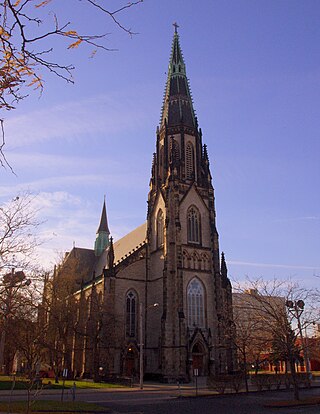
St. Joseph Shrine, founded in 1855, is a historic German Catholic church located at 1828 Jay Street in the Eastern Market–Lafayette Park neighborhood area just outside downtown Detroit, Michigan, on the city's central east side. The building was listed on the National Register of Historic Places in 1972, and deemed "of national importance" because of its stained glass. Three subsidiary buildings—the rectory, convent, and the Wermers House—were added to the listing in 1992. It is under the jurisdiction of the Archdiocese of Detroit, and presently a shrine dedicated to the celebration of the pre-Vatican II liturgy under the care of the canons of the Institute of Christ the King Sovereign Priest.
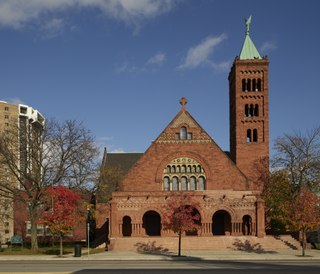
The First Congregational Church is located at 33 East Forest Avenue in Midtown Detroit, Michigan. It was designated a Michigan State Historic Site in 1974 and listed on the National Register of Historic Places in 1979.
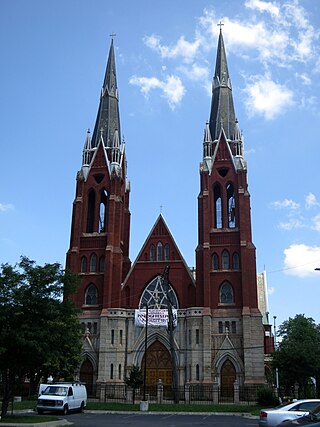
The Sweetest Heart of Mary Roman Catholic Church is located at 4440 Russell Street in Detroit, Michigan, in the Forest Park neighborhood on the city's central East side. The Gothic Revival cathedral styled church is the largest of the Roman Catholic churches in the City of Detroit. It was designated a Michigan State Historic Site in 1974 and listed on the National Register of Historic Places in 1978. It, along with St. Albertus Roman Catholic Church, 0.4 miles east on East Canfield Street, and St. Josaphat Roman Catholic Church, 0.3 miles west at East Canfield Street and Chrysler Drive, served the large Polish community through most of the twentieth century. In a diocesan reorganization instituted by Archbishop Allen Vigneron in 2013, Sweetest Heart of Mary joined with St. Josephat to form Mother of Divine Mercy Parish.

The Sacred Heart Roman Catholic Church, Convent and Rectory is a Roman Catholic church complex located at 1000 Eliot Street in Detroit, Michigan. It was designated a Michigan State Historic Site in 1975 and listed on the National Register of Historic Places in 1980.

The Chapel of St. Theresa–the Little Flower was a church located at 58 Parsons Street in Midtown Detroit, Michigan. It was later known as St. Patrick Church. The building was listed on the National Register of Historic Places in 1997, and demolished in September 2023.

Sts. Peter and Paul Academy is a Catholic school building located at 64 Parsons Street in Midtown Detroit, Michigan. It currently serves as the St. Patrick Senior Center. It was listed on the National Register of Historic Places in 1997.
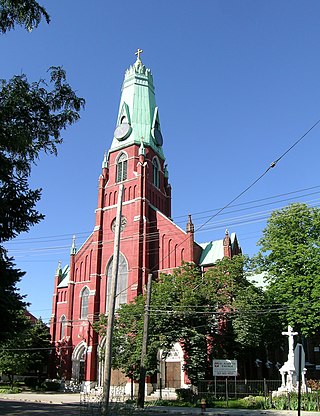
St. Albertus Roman Catholic Church is in the Forest Park neighborhood of Detroit, Michigan. It was designated a Michigan State Historic Site in 1974 and listed on the National Register of Historic Places in 1978.
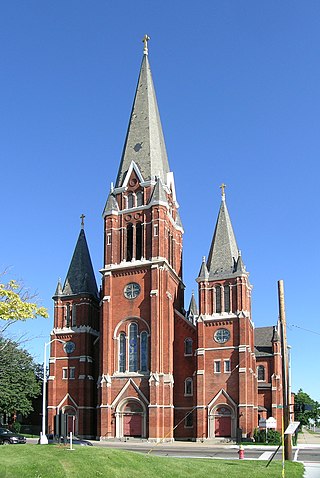
St. Josaphat Roman Catholic Church is a Roman Catholic church located at 715 East Canfield Street in Detroit, Michigan. It was listed on the National Register of Historic Places in 1982 and designated a Michigan State Historic Site in 1985. Since 2013, it has been one of two churches that comprise Mother of Divine Mercy Parish.

Christ Church Detroit is an Episcopal church located at 960 East Jefferson Avenue in Detroit, Michigan. It is also known as Old Christ Church, Detroit. It is the oldest Protestant church in Michigan still located on its original site. It was designated a Michigan State Historic Site in 1970 and listed on the National Register of Historic Places in 1971.

The Most Holy Redeemer Church is located at 1721 Junction Street in Southwest Detroit, Michigan, within the West Vernor–Junction Historic District. The church was once estimated as the largest Roman Catholic parish in North America. West Vernor–Junction Historic District is adjacent to Mexicantown and contains a growing Mexican community and resurgent neighborhood.

St. Mary Roman Catholic Church, formally the Church of the Immaculate Conception of the Blessed Virgin Mary, is in the third oldest Roman Catholic parish in Detroit, Michigan. Designed by German-born Peter Dederichs and built for the formerly ethnic German parish of the 19th century, it is located at 646 Monroe Street in what is now considered the heart of the Greektown Historic District in downtown Detroit. It is often called "Old St. Mary's Church" to avoid confusion with other St. Mary's parishes: in the Redford neighborhood of Detroit, or in nearby Royal Oak, Monroe, or Wayne.
The Hungarian people and Hungarian Americans immigrated to Metro Detroit in the 20th century. Historically they populated Delray in Detroit but moved to the Downriver area in the 1960s. There were four historic waves of Hungarian immigration to Detroit.
Frank Varga was a Hungarian-American sculptor. He was the only child of the artist Ferenc Varga and his wife Anna Pázman Varga.